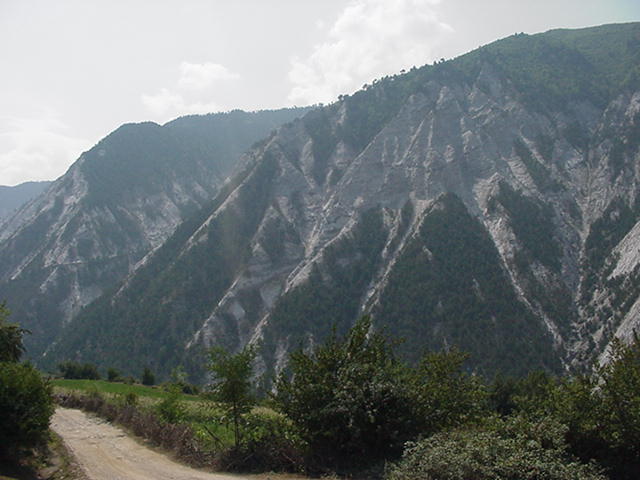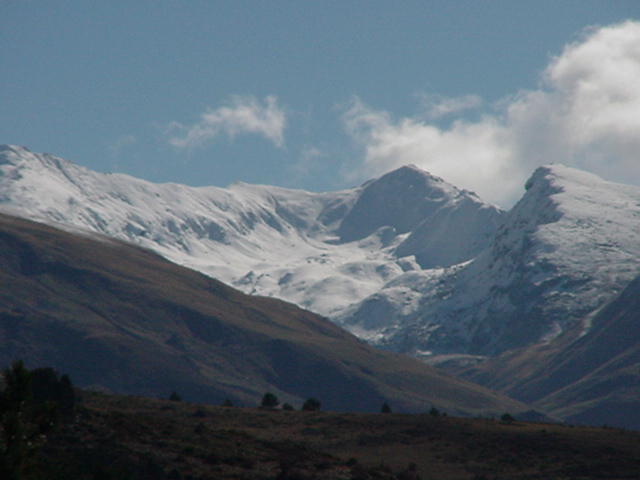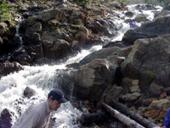 "Kala
e Dodes" is the gate to Korabi and it can be a shelter for those who would like
to reach the top of The Korabi mountain, the highest in Albania and the third in
Balkans peninsula.
"Kala
e Dodes" is the gate to Korabi and it can be a shelter for those who would like
to reach the top of The Korabi mountain, the highest in Albania and the third in
Balkans peninsula.ECODIBRA AND TOURISM
Eco-Dibra and Tourism?!
Activities: management of eco-tourism in Dibra Region.
Implementing Agency: "Ecological Club" Association of Dibra Region
Address: Bulevardi "Elez Isufi" Albania
e-mail: ecodibra@hotmail.com
Contact Person Luan Leka, Veli Shehu
Peshkopi, April,2003.
Preface:
The Dibra region is located in the east of Albania in a mountainous terrain, of ten combined parts of the so called "Low zone", which starts from the Black Drini River up to the high lands, to the border with the Republic of Macedonia.
The peaks of The Korabi mountain are the highest in Albania stand in file, and have a rare beauty.
The crests of these mountains are of lime and gypsum formation covered with herbage plants and alpine pastures with defend kinds of flowers and greenery of these land scares during spring and summer. Different colorful flowers, cold water sources, cataracts, natural lakes, evergreen trees and leaf falling ones make it a very attractive spot for the visitors.
Places such as Kala e Dodes, with the peak of The Korabi mountain in the East and the alpine pastures, the Grama area and its pastures, with carstic natural lakes, and artificial ones in the center of Grama together with the evergreen pine and fir-trees are surely the pearls of our region.
"KALA E DODES "AREA
Welcome to Kala e Dodes ,the gate of the highest mountain in Albania.
 "Kala
e Dodes" is the gate to Korabi and it can be a shelter for those who would like
to reach the top of The Korabi mountain, the highest in Albania and the third in
Balkans peninsula.
"Kala
e Dodes" is the gate to Korabi and it can be a shelter for those who would like
to reach the top of The Korabi mountain, the highest in Albania and the third in
Balkans peninsula.
There are two ways to get to these characteristic villages of "Kala e Dodes".
Kala e Dodes county – seat lies in the northeast of Peshkopia. Its the closest point to Peshkopi is 30 km and the furthest point from Peshkopi is 40 km.
It is there where you find three of the most important sources of life: the very clean air , the cold and probably the tastiest water in our country, the livestock products, such as meat and dairy of the best quality. Housing conditions are generally modest, improving day after day, however. There is an increase in the number of the newly built villas, which have all the accommodations one could be looking for.
Korabi Mountain

This mountain is the highest mountain of the whole range of mountains, and it is not only the highest mountain in Albania, but also one of the highest in Balkans. The Korabi lies between the valleys of Veleshica stream and the Grama stream.
Its back is divided in three main ridges from contact pits like that of "Fair", "Leek" corrals and "Shehi" Pastures.
"Fair Field"
The best-known among these is the "Fair" pit. It has got a great landscape. Korabi peak stands over it, meanwhile it has got the form of a stadium over which a fountain with the coldest water in Albania, stands up. The locals recommend that the "Fair" water should be drunk by pipes only, because direct use of it, causes problems and this is because it is very cold. If you happen to be there in June, you could also find snow and colorful flowers in the same time, which makes it a unique beauty. This spot was called "Fair" because originally it was the place where livestock fairs took place and all the Balkans came there to buy or sell cows, sheep, horses etc. This oval pit has got a rather flat bottom and it hangs over the glacial valley of the Korabi plain in the north; its threshold is about 200 m high.
The "Fair" pit has got two ridges: that of Morava (2716 m ) and the one of Rosnik 2576 m which converge at The Korabi peak. The main characteristic of these rocks are the marbled lime stripes of the ridges. The glacial cirques carved on these ridges, make complex cranes presented better than anywhere else. They are scale-like and end up in the glacial valley of The Korabi plain in the north, and the "Fair" pit in the east.
The "Fair" pit is separated from that of "leek corrals" (this is where the drinking water for Peshkopia comes from) ridge of Korab Morava making a slope 700 m high.!!!!!!!!!
The Korabi Plain
Normally, the visitors have to cross The Korabi plain before they get to "Fair". The locals call this plain " The Korabi Field" and it historically served as a bridge to connect "Kala e Dodes" with the Albanians of Macedonia and Kosovo. This is also the reason why the locals dedicated many of their songs and legends to this field. In summer, it is full of corrals and flocks of sheep. It looks like an enormous carpet, decorated with the most colorful flowers which obviously take turns week after week.
Being in the north of the mountain, this field looks like a washbasin of 3 km long. There are several thresholds here and there, down to the village of Radomira, where the village hills come together.
Apart from the fresh air and its stunning beauty, the visitors can find ski runs and lots of space for other winter activities. The snow on this plain, doesn't melt for more than months. It doesn't take more than an hour walk, from the Village of Radomira to The Korabi plain and this could be just the beginning of a very exciting trip to the visitors. And The Korabi plain or the "Fair" are not the only two beauties to be seen and enjoyed. There are other distinguished spots which take your breath away.
The "Leek" pit is even wider than the "Fair"
There are thresholds which reach up to the village of Radomire. It is in the lowest threshold where you can still five glacial lakes, which are running dry , but yet are worth to visit.
"Korabi Gates"
 The
other ridge of this mountain is the one called " Korabi
Gates" which is separated from Korabi peak by the
mountain pass with the same name, "Korabi Pass" (2475 latitude). This ridge,
where two mountain peaks of 2700m high come up, separates "The leek corral" pit
from "Shehu" pastures. The last one, has grown deeper and deeper because a
branch of the River Veleshica goes through it and it has become kind of valley.
Subzero temperatures and frost have led to the creation of stone streams which
come down to the feet of the mountain.
The
other ridge of this mountain is the one called " Korabi
Gates" which is separated from Korabi peak by the
mountain pass with the same name, "Korabi Pass" (2475 latitude). This ridge,
where two mountain peaks of 2700m high come up, separates "The leek corral" pit
from "Shehu" pastures. The last one, has grown deeper and deeper because a
branch of the River Veleshica goes through it and it has become kind of valley.
Subzero temperatures and frost have led to the creation of stone streams which
come down to the feet of the mountain.
If the visitors want to go towards The Grama mountain (which is part of this amazing collection), this mountain pass goes lower and lower because the rapids take place in stead of the lime stones. On the other hand, the western side of this mountain pass grows steeper at the glacial part "Ladies' pasture" right between The White mountain at The Grama mountain.
This hillside in formed because of the tectonic contact of the rapids with the gypsum of The White mountain, comprising a kind of lithologic threshold. The presence of gypsum has preserved the area from erosion that the River Grama would have caused over the years. This threshold was transformed into a slope during the ice-age and nowadays it is approximately 2 km long by 1 km wide and two glacial lakes are on it.
The most remarkable part of it is The Lushi stream, which is famous for the beautiful spring flowers growing along its banks and for the wealthy biodiversity, particularly for the very rare species.
Each and everyone of the visitors in Korabi would be amazed of sharp contrasts between the very high alpine peaks and the valleys, mount gorges, notches and deep pits.
Plants, animals and also the abundant watery urchins add values to these landscapes, comprising a great property and that is the future of the tourism.
LURA
And Lura is not far behind. It is so special and it is considered
as an alpine pearl with its varied coniferous forests.

Its villages are settled over several valleys and plains, but the culmination of its beauty are the seven carstic natural lakes, which are a rare natural beauty.
"The Mare’s Valley", 20 acres of land is surrounded by pine and fir trees making a stunning landscape, where, according to some elders, horse races were organized in very early times. That's why it is called "The Mare's Valley".
Lane-Lura.
This is a plain on an altitude of 1200 m and it is very much like a natural stadium, overlooking Lura.
It forms the valley called "Six fingers" which is beautiful to look at.
Huge flocks of sheep graze around "Six finger" pastures in spring and summer, enjoying the fresh and mild grass and the colorful flowers.
Fushe-Lura
 When
you come down from Lane Lura along the winding paths, you can see the hugest
plain of Lura, called Fushe-Lura, unfolding its beauty to you.
When
you come down from Lane Lura along the winding paths, you can see the hugest
plain of Lura, called Fushe-Lura, unfolding its beauty to you.
It is also the administrative center of Lura and the high mountains all around it covered with coniferous trees make it more attractive. There are hardly any arable plots here; it's mainly meadows full of colorful flowers and grass. The folks over here are well-known for their hospitality. They are poor in general but their biggest treasure are their big good hearts. Most of them breed sheep and keep bees and this is the main way of making a living. Their everyday life is closely connected to the forest and the small surface of arable land. And the wood accompanies them throughout the year.
A river flows across the plain and it is special for its crystal-like water whose source is high in the mountains.
The Old Lura
The Old Lura lies only 2 km on the west of Fushe –Lura. Some ten years ago, the sawmill department of the former wood exploitation enterprise, was sited here. There are lots of water springs and the pine and fir trees accompany you everywhere around here. There is a church for the catholic religious people of the area, right in the center of the village.
"The Lakes of Lura"
Starting from The old Lura the motorway leads you directly to the seven lakes of Lura. On the way to the lakes, the visitors can see the beauty of the mountains covered with woods and hear the chirp of the birds and sparrows. Here and there you can even hear heath cocks which are hard to be found in other areas.
Such landscapes can be seen even in Ilnica (Hinoska) and the highlands of Pocest where is a fantastic waterfall.
In Bulqiza, among the forests of Ternova, the landscape is natural and unspoiled and natural lakes make it unique. But the beauty of nature gets more interesting and attractive when it gets mingled with the stories of the local folks, their ever life with the forest, pastures and livestock. They are historically hospitable and very kind with the guests, always ready to tell their stories and to give any necessary information. the different villages have different traditions regarding cooking, growing vegetables, fruit-trees or whatever.
Copyright © 2003 [Ecodibra]. All rights reserved.